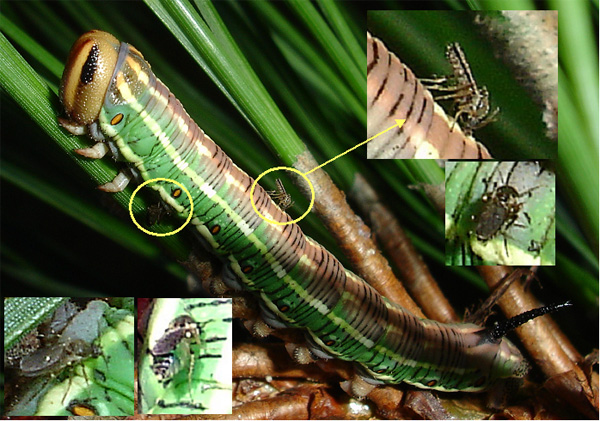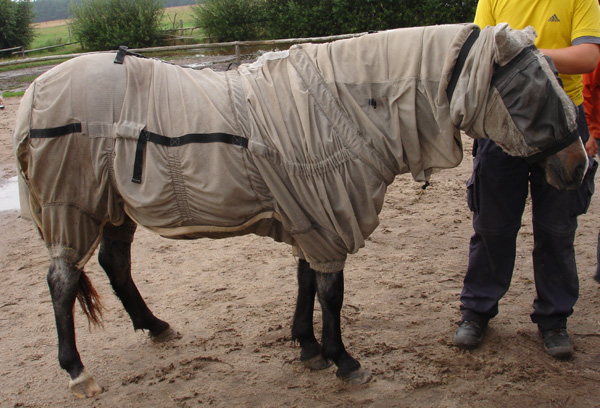Diptera.info :: Identification queries :: Diptera (adults)
|
caterpillar with dipteran "bloodsuckers"??
|
|
| Sundew |
Posted on 23-09-2007 22:13
|
|
Member Location: Berlin and Baden-Württemberg, Germany Posts: 3939 Joined: 28.07.07 |
Hi, Yesterday I took some photos of a caterpillar of Hyloicus pinastri (pine hawkmoth). By zooming I detected two extremely tiny gnats (?) attached to its body that were obviously sucking. The camera could hardly depict them. Today I looked at the caterpillar again and found the gnats still in place. Their abdomina were clearly swollen (detail pics below) compared to the pics from yesterday in the upper right, so they obviously had continued sucking. They were not fixed to the caterpillar (like, e.g., a tick is) and changed the position when touched but did not fly off. There are many insects that place their eggs on caterpillars, but I have never heard of "bloodsuckers" (or better, lymphsuckers) that attack caterpillars. So I would greatly appreciate any information about this subject - which flies or gnats, respectively, are to be considered, and is the caterpillar's life endangered by their activity? Many thanks in advance, Sundew Sundew attached the following image:  [156.31Kb] |
|
|
|
| jorgemotalmeida |
Posted on 23-09-2007 22:20
|
|
Member Location: Viseu - PORTUGAL Posts: 9296 Joined: 05.06.06 |
simuliidae?  Not sure. the resolution is not enough to see well the fly. Not sure. the resolution is not enough to see well the fly. |
| Xespok |
Posted on 23-09-2007 22:30
|
|
Member Location: Debrecen, Hungary Posts: 5551 Joined: 02.03.05 |
Ceratopogonidae. Simuliids have shorter antennae, and to my knowledge parazitise verterbrates.
Gabor Keresztes Japan Wildlife Gallery Carpathian Basin Wildlife Gallery |
| Tony Irwin |
Posted on 23-09-2007 22:33
|
|
Member Location: Norwich, England Posts: 7327 Joined: 19.11.04 |
Ceratopogonidae, probably Forcipomyia. Many ceratopogoninds feed on insect haemolymph, either directly from the body or from wing-veins. Forcipomyia are well-known as caterpillar suckers.
Edited by Tony Irwin on 23-09-2007 22:34 Tony ---------- Tony Irwin |
|
|
|
| mwkozlowski |
Posted on 24-09-2007 09:58
|
|
Member Location: Warsaw, Poland Posts: 796 Joined: 17.10.06 |
could it be the same on a cockchafer ? |
|
|
|
| mwkozlowski |
Posted on 24-09-2007 09:59
|
|
Member Location: Warsaw, Poland Posts: 796 Joined: 17.10.06 |
could it be the same on a cockchafer ? |
|
|
|
| mwkozlowski |
Posted on 24-09-2007 10:00
|
|
Member Location: Warsaw, Poland Posts: 796 Joined: 17.10.06 |
could it be the same on a cockchafer ?
mwkozlowski attached the following image:  [54.41Kb] |
|
|
|
| Tony Irwin |
Posted on 24-09-2007 20:49
|
|
Member Location: Norwich, England Posts: 7327 Joined: 19.11.04 |
Yes, several ceratopogonids also feed on beetles.
Tony ---------- Tony Irwin |
|
|
|
| Sundew |
Posted on 25-09-2007 22:55
|
|
Member Location: Berlin and Baden-Württemberg, Germany Posts: 3939 Joined: 28.07.07 |
Thanks to all! This was a very interesting discussion. The world of the small creatures really deserves closer attention. So much exciting is overlooked by the general public because of its tininess. I am so glad I found this forum. Thanks again, Sundew |
|
|
|
| Tony Irwin |
Posted on 25-09-2007 23:50
|
|
Member Location: Norwich, England Posts: 7327 Joined: 19.11.04 |
Ceratopogonids are getting quite a bit of attention in England at present, because we have just had our first cases of Blue Tongue Virus. I even had the local TV station interviewing me today about Culicoides! (I couldn't get in a plug for Diptera.info, though!) 
Tony ---------- Tony Irwin |
|
|
|
| jorgemotalmeida |
Posted on 26-09-2007 00:11
|
|
Member Location: Viseu - PORTUGAL Posts: 9296 Joined: 05.06.06 |
http://news.bbc.co.uk/1/hi/uk/7008788.stm .... and "Bluetongue has been observed in Australia, the USA, Africa, the Middle East, Asia and Europe. Its occurrence is seasonal in the affected Mediterranean countries, subsiding when temperatures drop. It has been spreading northward since October 1998, perhaps as a result of global warming.[2] In August 2006, cases of bluetongue were found in the Netherlands, then Belgium, Germany, and Luxembourg.[3][4] In September 2007, the UK reported its first ever suspected case of the disease, in a Highland cow on a rare breeds farm near Ipswich, Suffolk. [5] Although the disease is not a threat to humans the most vulnerable common breeds in the UK are cattle, goats and sheep." in wikipedia.. they are quick! |
| Sundew |
Posted on 26-09-2007 22:35
|
|
Member Location: Berlin and Baden-Württemberg, Germany Posts: 3939 Joined: 28.07.07 |
Culicoides is also responsible for the Sweet Itch or Summer Eczema in Icelandic horses. I use to go to a Icelandic horse breeding and riding stable for riding. Some of the about 100 horses have serious skin problems caused by allergens in the saliva of the midges during summer. Last year, a special jacket was tested and proved helpful, so several horses are equipped with full-body covers now that are only removed for riding and immediately put on afterwards. The horses look like mummies but obviously feel fine. So the constant application of corticoid ointments could be much diminished. Small midges - big effect! Sundew Sundew attached the following image:  [137.85Kb] |
|
|
|
| John Carr |
Posted on 22-12-2013 00:18
|
|
Super Administrator Location: Colorado, USA Posts: 10562 Joined: 22.10.10 |
In 1972 Willis Wirth wrote: "In 1956 (Ann. Ent. Soc. Amer. 49: 356-364) I reviewed all the published records and available museum specimens of these caterpillar parasites and concluded that all pertained to Forcipomyia fuliginosa (Meigen), a common species with nearly worldwide distribution. I have just finished going over the museum material and literature again, and although I can now recognize several distinct local species of caterpillar parasites in tropical America, F. fuliginosa still remains as the main species attacking lepidopterous larvae around the world. It also occasionally attacks other soft-bodied insects such as sawfly larvae, dragonflies, and meloid beetles." |
| Jump to Forum: |













